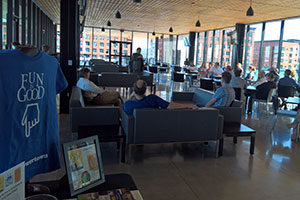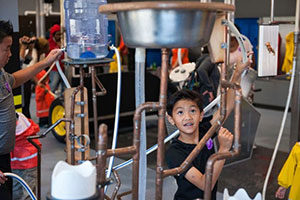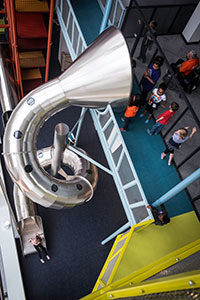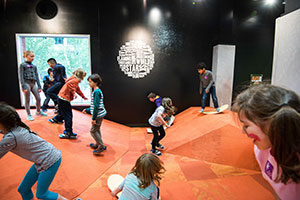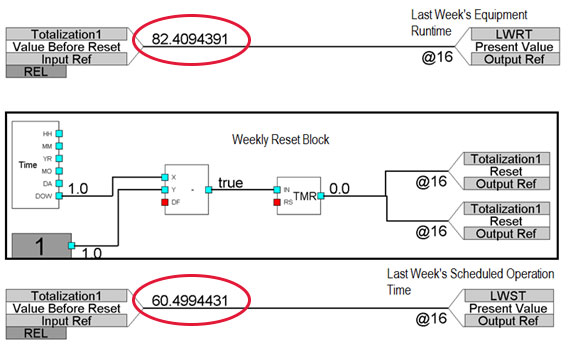Letter from the President
The end of summer has always been one of my favorite times of the year. We are usually nearing the completion of major summer construction projects and the important offseason maintenance work in the plant. The heat of summer begins to wane, but we are still enjoying great evenings of baseball at CHS Field and dinner on the great Saint Paul patios. This year, the seasonal transition has also been punctuated by exciting changes with some of our partners. As a Saint Paul Area Chamber of Commerce board member, I was thrilled to welcome Brenda Kyle to the organization as the new President. We have had the privilege of collaborating with B during her time with the Saint Paul Port Authority, another stellar partner, and we are excited for this new chapter for her and the organization.
In addition to the aforementioned partnerships, our team looks at our work with our customers as a partnership. We work together to find ways to save energy and money and operate systems more effectively. And some may not realize that our primary systems actually integrate with customer systems to help supplement our primary production and continue our strong history of reliability, while still helping the system be cost-effective and flexible to needs. Regions Hospital has long been a valued partner who uses their central heating and cooling plant as a resource to support the reliability of the heating and cooling systems.
We are also excited to share the news from two of our customers that specialize in fun in Saint Paul. First, we are looking forward to sponsoring a new endeavor by the St. Paul Saints. The Saints are bringing together their partners, corporate sponsors, season ticket holders, and fans to converse, connect, and build community. The 3 C’s Club will offer event guests the opportunity to network and hear from unique speakers that will share their experiences through jokes and stories. At the first gathering in June, we met many new people that we look forward to getting to know better.
In this newsletter, you can learn more about the newly renovated Minnesota Children’s Museum. The Museum recently reopened after an innovative remodel that focuses on play. We could not be happier for the great reception the changes have received from the community.
Thank you to all of our partners for the ways that you help us to continually improve our service to grow our system together with our community.
Minnesota Children’s Museum Reimagined
Kids and adults are loving the reimagined Minnesota Children’s Museum since it reopened in June. After an extensive renovation to the building and exhibits, everything is new. District Energy has provided cooling to the museum since it opened in Saint Paul in 1995, and the remodel provided the perfect opportunity to expand our services to include heating and domestic hot water. We are excited to be part of the inspiring transformation of this regional destination.
The remodel is the museum’s first extensive overhaul of exhibits and the building since they moved to the Saint Paul location. The exhibits were redesigned with the philosophy that open-ended activities give children the space and freedom to explore, putting children and their imaginations in the driver’s seat. Activities without directions or predetermined outcomes encourage kids to figure things out for themselves as they experiment, tinker, and work together. Beyond the joy of free play, the goal is to help kids develop lifelong skills such as creative thinking, confidence, collaboration, and critical thinking.
“We’ve created a bigger, better, and bolder children’s museum,” said Dianne Krizan, president of Minnesota Children’s Museum. “Families will find ways to play, explore and learn together like never before.” There are 10 all-new exhibits that appeal to children from 6 months to tweens. Most of the exhibits have special areas called “Tot Spots” especially for younger children. A couple of highlights include The Scramble — a 4-story climbing adventure with a 2-story slide, The Studio — a maker space with real tools and authentic materials, and Super Awesome Adventures, which includes a green-screen climbing wall, laser maze, and carpet skate park. Plus there are two outdoor galleries that are open seasonally.
As soon as you step through the museum entrance, it is clear that kids love the new space. Adults will love it too. During the remodel the museum increased visitor space by 35%, added more restrooms, as well as a café with coffee bar, improved flow and sightlines throughout the museum, and added an entrance on the skyway level.
At District Energy we congratulate the museum on their exciting redesign. We are proud to take the worry out of energy production, so that the team at the museum can focus on their visitors having fun. In addition to museum’s great exhibits, the museum hosts a variety of activities and events including birthday parties, a 21+ event called “Adults @ Play” on September 28, and Halloween parties on Sunday, October 29 and Monday, October 30.
Ask the Engineer – Getting the Most out of Your Building Automation System
This is the first of two articles that will focus on your building automation system. In this article, we will share some suggestions on using totalizers to verify equipment run time and using pressure independent valves to monitor energy. Building automation can help building engineers monitor, integrate, and control building systems from air handling units to lighting. By taking some time to set up some operational parameters, you can gain insight beyond past trends and failure alarms to identify problems in system function. Many control points or objects have built in features that take a few steps to enable.
The cheapest and easiest way to save energy is to simply turn off equipment when it does not need to run. A basic step in setting up a building’s automation system is to establish a schedule. Scheduling generally reflects building occupancy and tells equipment when to turn on and off to accommodate the needs of the people in the building. With a schedule in place, you can set up a simple cross-check to make sure that all the equipment is running for the desired amount of time per the schedule by enabling the totalization property on both the schedule object and the equipment status. The totalization property counts all the time that a piece of equipment is running or the hours that the schedule is occupied. By checking the equipment runtime each week against the appropriate schedule it will be apparent if the equipment did not run long enough, ran too long, or may not have shutdown at all. This simple check will help to ensure that you are optimizing the amount of energy your building is saving.
Figure 1 below shows a sample of the programming that includes point totalization, resets, and the value before reset properties of each points. This example shows a fan that ran 22 extra hours above its schedule, which in this case is 35% longer than it was supposed to. Not only does this represent additional fan energy, but it can also represent running cooling or heating pumps longer, conditioning more outside air, and increasing equipment maintenance and repair.
If you have ever wondered if different pieces of equipment run with the same efficiencies or which parts of your building take more energy to provide the same comfort, then installing pressure independent valves and/or energy valves may be a low-cost option to provide some proportional insight into energy saving opportunities. In order to calculate energy usage, you need two things: fluid flow rate and the differential temperature before and after the device. These types of control valves by design allow for precise control for consistent water flow at air handling units, fan coils, and other hydronic devices. Temperature sensors and a well to install them can cost between $50-$100 plus the labor to install them. A good time to install pressure independent valves is when you are replacing existing valves or at the time of new project or major remodel. With these devices, the building automation system can be used to calculate, trend, and totalize the energy being used from each piece of equipment. Weekly or monthly comparisons can be made between different devices as well as the history of the same device to identify when equipment may be using excess energy. This could help to identify issues like plugging or coating coils, failed dampers, and equipment that is taking energy even though its associated fan or pump is supposed to be turned off.
By enabling your totalization settings and adding pressure independent valves, you can enhance your building automation system to gain a better understanding of your building’s actual energy use. In addition to saving money on energy, these tools can help you to identify equipment issues. If you have questions about energy savings opportunities or your District Energy connection, please contact the customer service team at 651.297.8955 or info@districtenergy.com.
Welcome Holly Jasper
The District Energy public relations team welcomes a new member, Holly Jasper, as our Marketing and Communications Coordinator. Her recent experience is in the local construction industry where she gained extensive experience in developing proposals and presentations to win new projects. Holly’s skills in design and marketing are a great addition to our team. She is getting to know our customers and learning about our system’s technologies. She said, “I am looking forward to working with the District Energy team and the challenge of learning this industry.”
Holly has worked in marketing for McGough, Mortenson, and Knutson Construction. In her spare time, she likes to bake and kick box. She graduated from the College of St. Scholastica with a BA in accounting. She worked in accounting for four years before shifting her career to marketing.
Contact Updates
It is important to us that we have accurate contact information for our customers. We are in the process of reaching out to organizations to confirm that we have correct information for your building. If you have not updated your contact information with us this summer, please take a moment to complete the Contact Update Form.

